KEDLESTON PARK WALK
THE WALK
This lovely walk takes you through open parkland and woodland, along good, easy-to-follow paths with only gentle gradients. There are excellent views across the park of the southern side of Kedleston Hall on what is classified as the ‘Long Walk’. In wet weather, the walk can be quite muddy and slippery in places. The route may easily be divided into two if you want a shorter walk. Alternatively, the National Trust provides a leaflet containing several self-guided walks. As this walk can only be completed when the park is open, it is advisable to check the opening and closing times before travelling. There is a charge for non-National Trust Members to visit the park.

Route Point 1 – Bentley’s Well lies halfway between the house and the bridge, on the right-hand side of the driveway as you leave the house. It is a Grade II listed, with a gabled canopy and a lion mask from which the water flows. It apparently took its name from a steward at the house of that name. It is also known as Lion’s Mouth and has a reputation for good clear water.
Point 2 – The handsome Adam Bridge over the lake in Kedleston Park was designed by Robert Adam and dates from 1770-71. It is a Grade I listed building. Adam’s original intentions were for a single-arch bridge to be built as revealed in his sketchbook of 1759. However, he changed his mind and when it was built in 1770/71; it had three arches and looked much more impressive than what was originally intended both for visitors crossing the bridge and when viewed from the house. The change of mind may well have been brought about by the site of James Paine’s magnificent, three-arched bridge at the entrance to Chatsworth House, which was built in 1762. The original stone balustrade did not last long and had to be replaced in 1806 by a series of cast-iron balusters.
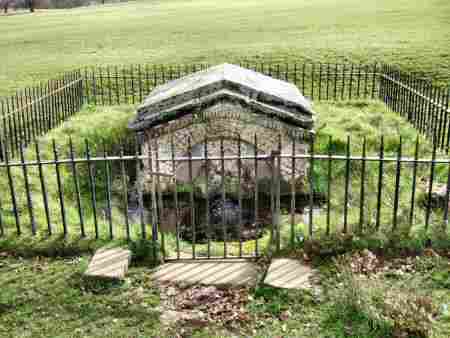
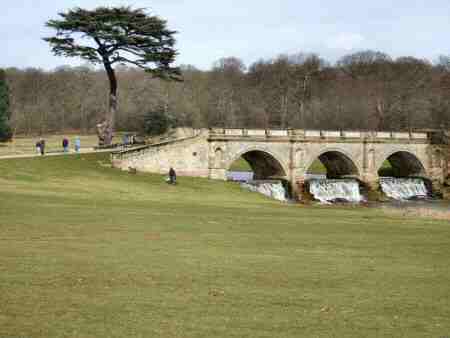
Point 3 – The Fishing Room is probably the finest of Adam’s garden buildings, built in 1770/72 on the upper lake at Kedleston, with a cold bath below it, flanked by two boathouses. Fortunately for those who took a plunge into the water, in cold weather, there was a fireplace inside the fishing room. The interior was finely decorated much as Adam intended,
with the central Venetian window designed to enable ladies to cast their fishing lines.
Point 6 – On the north side of the house the park is dominated by a series of lakes which replaced a canal that fed Royal gardener Charles Bridgeman’s octagonal pond. Bridgeman had originally laid out the grounds in a formal geometric style, with terraces mounting the hill to the rear and a canalised stream and pond. The small brook that enters the estate from the northwest has been transformed on its journey through the park. First, it flows over weirs, before widening out and forming a near-circular lake with an island in the middle. The water then cascades, underneath the three arches of Robert Adam’s handsomely designed bridge into the middle lake. This lake and the lower lake were not completed until 1775, under the direction of the engineer and canal builder, Hugh Henshall. Beyond the lower lake are two more weirs, before the brook leaves the park

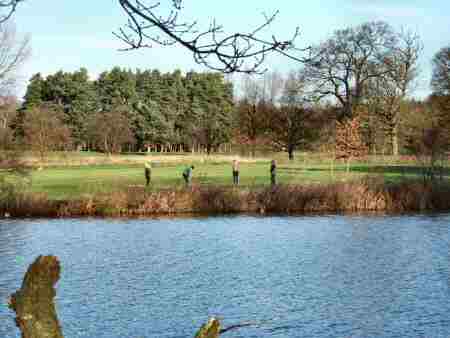
Point 8 – In the summer of 1759, Robert Adam prepared a sketchbook showing the Pleasure Grounds he was designing for the park at Kedleston Hall, laid out in the form of a winding circular path with temples alcoves and seats. The path closely resembles what is now called the Long Walk that you can still enjoy today. Although it appears natural the landscape is actually the result of good design to show the hall off to the best advantage. It was Adam’s first major job and he took to it with great enthusiasm. He laid out winding lawns lined with trees and shrubs, a gravel walk separated from the park by a ha-ha, to keep the animals at safe distance from the house and to provide the occupants with expansive views across the pleasure grounds which are one of the best-surviving examples of an 18th-century informal landscape.
Point 9 – Over several years the Hermitage, which sits under a large Plane tree on the Long Walk deteriorated into a ruinous state. Until the decision was made to restore it and after much painstaking work by craftsmen supported by heritage experts it was restored to its former glory. The little rustic, circular building was probably built about 1760 to a design by Robert Adam. In the middle ages, hermits were looked at as holy men. Appointed to lonely places by a bishop, they rendered hospitality and assistance to travellers. Later it became fashionable for landowners to build hermitages in parks for entertainment and in some cases to provide a home for a hermit.
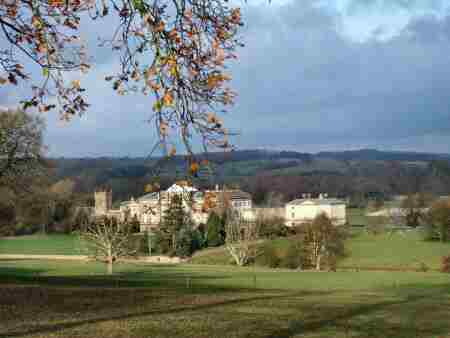
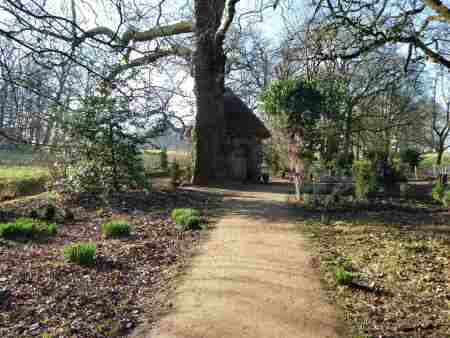
WALK DETAILS
Length: 4.75 miles.
Start: Kedleston Hall car park, off Kedleston Road, between Derby and Hulland Ward (SK312403).
Terrain: Mainly easy walking through parkland and woodland along clear paths with only gentle ascents and descents. The first part of the route takes you along both sides of Cutler Brook. It can be quite muddy in places after heavy rainfall.
THE ROUTE
. 1. From the car park, walk back through reception to the public entrance to Kedleston Hall, and then follow the drive down past Bentley’s Well, which is on your right, to the handsome bridge, which you can see a short distance away.
. 2. Do not cross the Adam Bridge, but turn left and follow the path by the upper lake. If you had crossed the bridge and followed the road, it would have taken you to North Lodge and the Kedleston Road entrance to the park.
. 3. After a short distance, you pass the Fishing Room soon followed by a weir. Continue along a well-trodden path close to the brook, until you arrive at a point close to Village Lodge. Here you will see several estate cottages just outside the park boundary. The drive from Village Lodge acts both as an entrance and exit to the park.
. 4. Cross the wooden footbridge by the park boundary to the other side of the brook. Once, on the other side, turn right and follow the path through a gate stile and over a small footbridge. Ignore the path to the left that leads deep into the area known as the Wilderness. Keep close to the brook along an obvious green path.
5. As you walk along you will get a good view of the island in the Upper Lake and you will be able to see the other side of the Fishing Room you encountered earlier in the walk. On reaching the Adam Bridge, cross over to the other side, and then immediately turn to the left.
6. Keep straight on first by Middle Lake and then the Lower Lake, with Kedleston Golf Course clearly visible on the opposite side of the lakes. The rather strange-looking building in the middle of the golf course is the Sulphur Bath House, built over a sulphur spring once believed to have beneficial health qualities. Maintain the same direction ignoring paths off to the right. On reaching the Splash Pool reportedly home to the UK’s native white-claw crayfish, kingfishers and otters. Here you turn right to follow a clearly defined track, as it rises gently uphill.
7. At a ‘T’ Junction of paths, keep left and walk up a surfaced track that winds a little more steeply uphill. Once you have reached the top, follow the path to the right along a tree-lined path.
8. Maintain the same direction, along an easy-to-follow path. Soon you will be treated to some excellent views of Kedleston Hall and the Pleasure Grounds. Continue straight on along the path, ignoring the ‘Short Path’ sign on your right.
9. Eventually, the path starts to bend to the right, as you gently descend the hillside back towards Kedleston Hall, keep a lookout for the Hermitage on your right.
10. Pass through a tall metal ‘House of Lords’ gate, and a few yards later turn left, to return to reception and the starting point of the walk.
